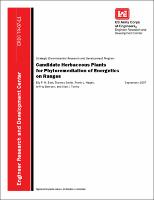Please use this identifier to cite or link to this item:
https://hdl.handle.net/11681/8515Full metadata record
| DC Field | Value | Language |
|---|---|---|
| dc.contributor | University of Illinois at Urbana-Champaign | - |
| dc.contributor | Analytical Services, Inc. | - |
| dc.contributor | Construction Engineering Research Laboratory (U.S.) | - |
| dc.contributor | Strategic Environmental Research and Development Program (U.S.) | - |
| dc.contributor.author | Best, E. P. H. | - |
| dc.contributor.author | Smith, Thomas S. | - |
| dc.contributor.author | Hagen, Frank L. | - |
| dc.contributor.author | Dawson, Jeffrey O. | - |
| dc.contributor.author | Torrey, Alan J. | - |
| dc.date.accessioned | 2016-06-20T13:27:26Z | - |
| dc.date.available | 2016-06-20T13:27:26Z | - |
| dc.date.issued | 2007-09 | - |
| dc.identifier.uri | http://hdl.handle.net/11681/8515 | - |
| dc.description | Technical Report | - |
| dc.description | Abstract: This report identifies rapidly colonizing and resilient grasses/forbs that are tolerant to range-relevant contaminants, with emphasis on TNT and RDX. A literature review identified herbaceous plant species with characteristics that make them potential candidates for use on ranges for phytostabilization and phytoextraction purposes. The review was limited to native and introduced grass and forb species, and species with improved genetic characteristics that have successfully been used on training lands in North America. The eight criteria used to select plant species for short-term screening experiments included: (1.) tolerance towards energetics, (2.) resilience-related life cycle characteristics and plant traits, (3.) typical biogeographic distribution, (4.) seed size, (5.) availability of propagules, (6.) photosynthetic pathway, (7.) exceptional traits, and (8.) other. Plant species reviewed included 64 grasses and 61 forbs. Based on initial review, eight grasses and eight forbs were selected for tolerance testing. Short-term screening experiments were conducted to evaluate the phytotoxicity of TNT- and RDX-spiked artificial soils to the plants. Seeds were exposed in the laboratory and germination was used as a parameter for plant response. Based on results of this experiment, five grasses and five forbs were identified as rapidly colonizing and short-term tolerant towards TNT- and RDX-contamination of soils. | - |
| dc.publisher | Environmental Laboratory (U.S.) | - |
| dc.publisher | Engineer Research and Development Center (U.S.) | - |
| dc.relation | http://acwc.sdp.sirsi.net/client/en_US/search/asset/1002747 | - |
| dc.relation.ispartofseries | ERDC TR ; 07-11. | - |
| dc.rights | Approved for public release; distribution is unlimited. | - |
| dc.source | This Digital Resource was created in Microsoft Word and Adobe Acrobat | - |
| dc.subject | Herbaceous plants | - |
| dc.subject | Phytoremediation | - |
| dc.subject | Energetics tolerance | - |
| dc.subject | Seeds | - |
| dc.subject | Germination | - |
| dc.subject | Vegetation | - |
| dc.subject | Firing ranges | - |
| dc.subject | Testing ranges | - |
| dc.title | Candidate herbaceous plants for phytoremediation of energetics on ranges | - |
| dc.type | Report | en_US |
| Appears in Collections: | Technical Report | |
